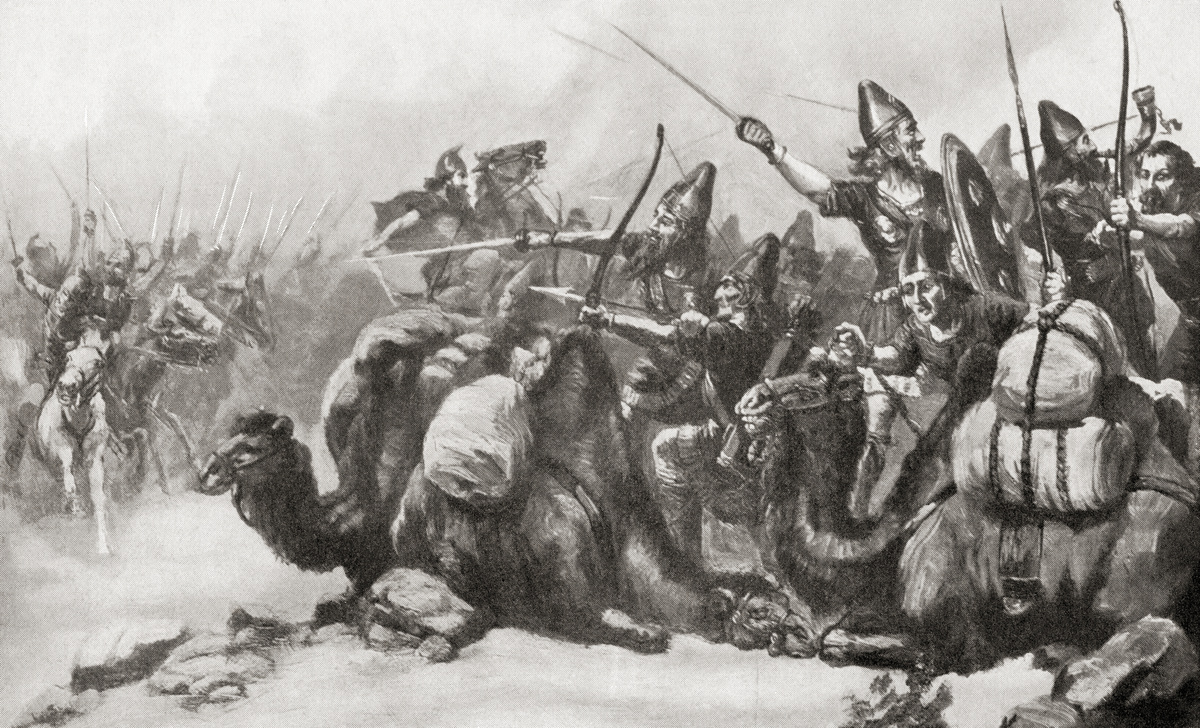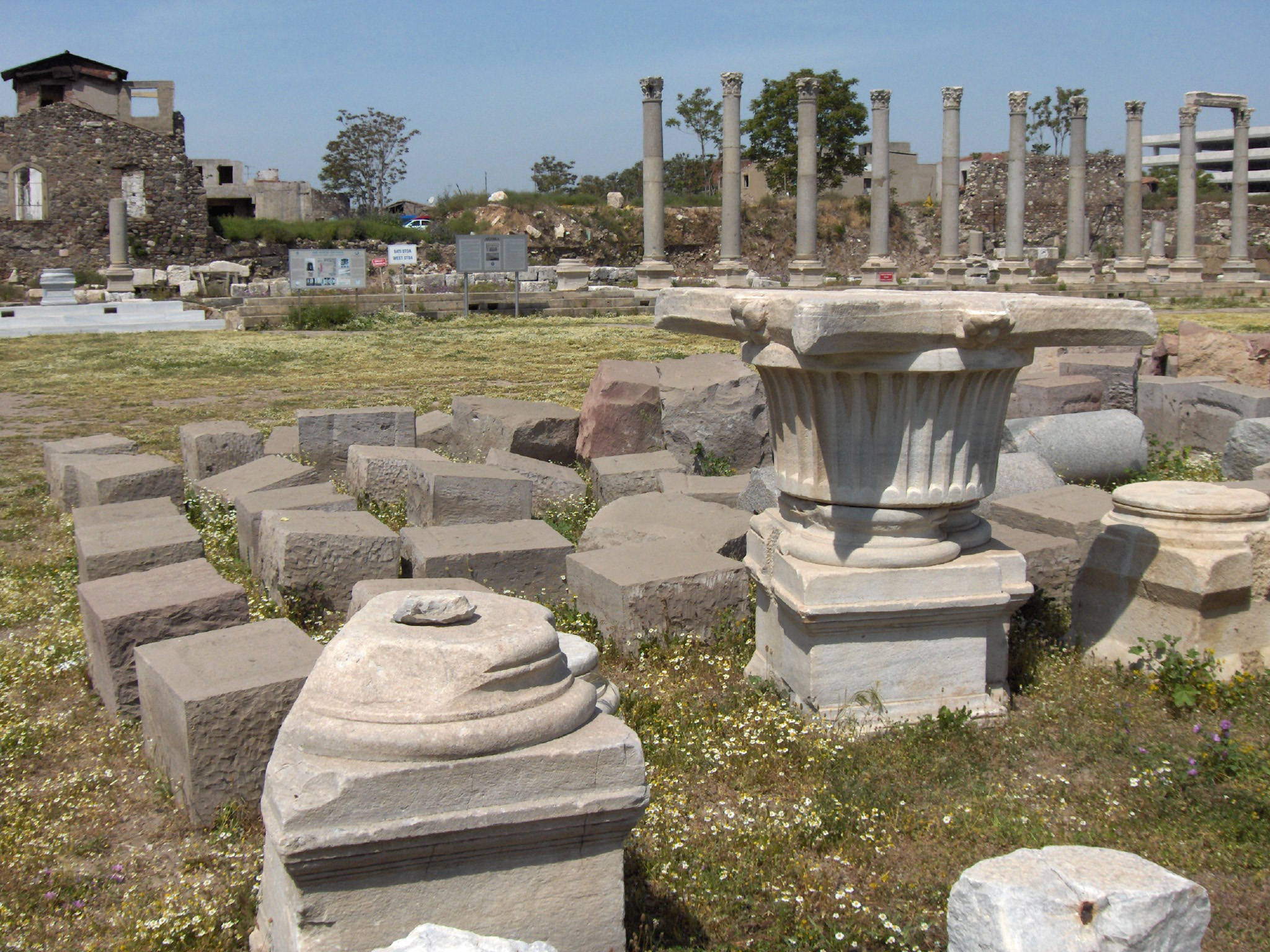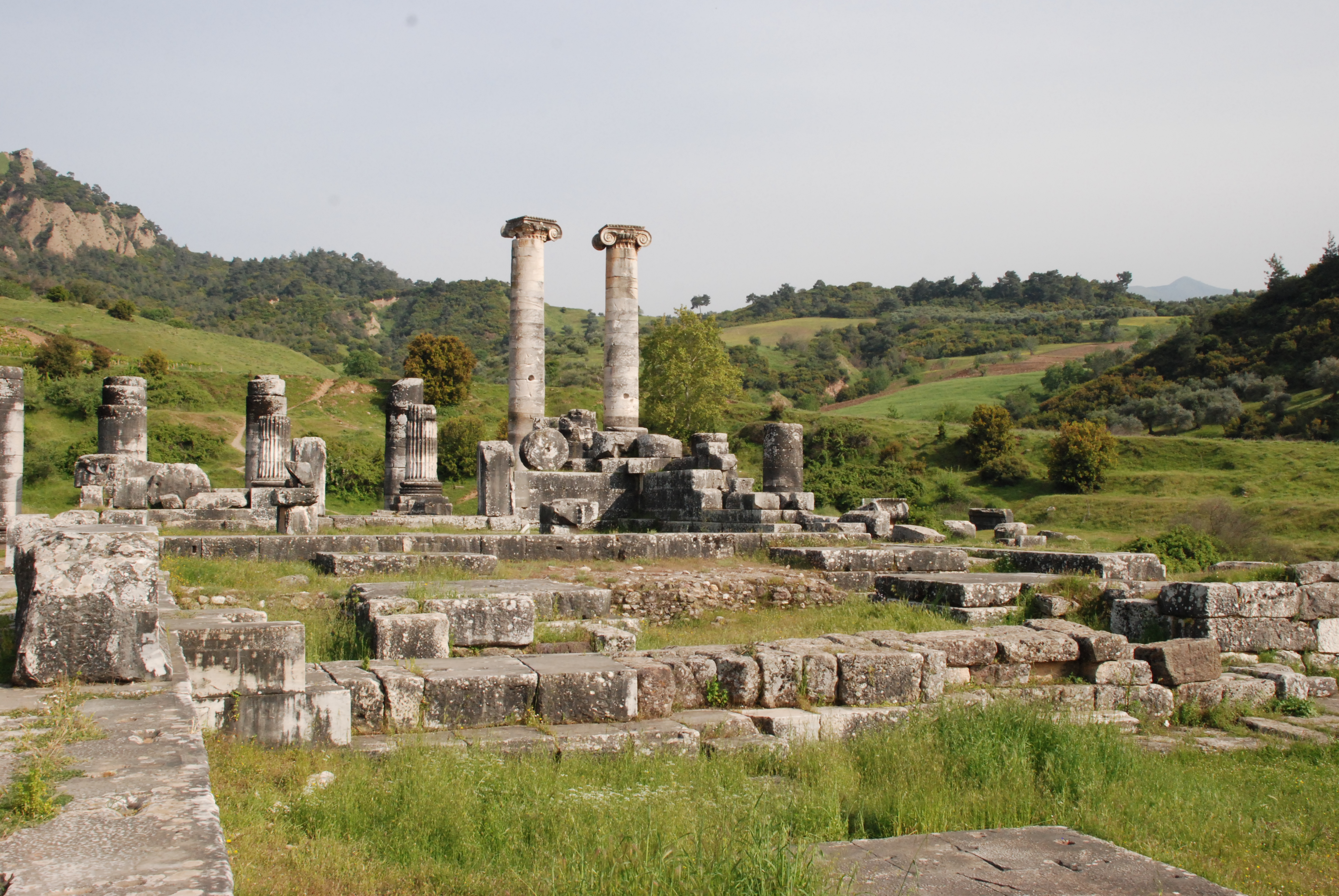|
Siege Of Sardis (547 BC)
The siege of Sardis (547/546 BC) was the last decisive conflict after the Battle of Thymbra, which was fought between the forces of Croesus of Lydia and Cyrus the Great, Cyrus followed Croesus to his city, laid siege to it for 14 days and captured it. Background The previous year Croesus, the king of Lydia, impelled by various considerations, invaded the kingdom of Cyrus the Great. Croesus hoped to quell the growing power of Achaemenid Persia, expand his own dominions and revenge the deposition of his brother-in-law Astyages. Also, Croesus thought himself certain of success since he was deluded by the ambiguous assurances of the apparently-reliable oracle of Apollo at Delphi. Croesus crossed the Halys and met Cyrus at Pteria in Cappadocia, but after a drawn-out battle against superior forces in which neither side obtained the victory, Croesus resolved to fall back for the winter, summon new allies and renew the war with reinforcements the next spring. In the interim, he disba ... [...More Info...] [...Related Items...] OR: [Wikipedia] [Google] [Baidu] |
Cyrus The Great
Cyrus II of Persia (; peo, 𐎤𐎢𐎽𐎢𐏁 ), commonly known as Cyrus the Great, was the founder of the Achaemenid Empire, the first Persian empire. Schmitt Achaemenid dynasty (i. The clan and dynasty) Under his rule, the empire embraced all of the previous civilized states of the ancient Near East, expanded vastly and eventually conquered most of Western Asia and much of Central Asia. Spanning from the Mediterranean Sea and Hellespont in the west to the Indus River in the east, the empire created by Cyrus was the largest the world had yet seen. At its maximum extent under his successors, the Achaemenid Empire stretched from parts of the Balkans ( Eastern Bulgaria– Paeonia and Thrace– Macedonia) and Southeast Europe proper in the west to the Indus Valley in the east. The reign of Cyrus lasted about thirty years; his empire took root with his conquest of the Median Empire followed by the Lydian Empire and eventually the Neo-Babylonian Empire. He also led an expedit ... [...More Info...] [...Related Items...] OR: [Wikipedia] [Google] [Baidu] |
Battle Of Pteria
The Battle of Pteria ( grc, Πτερία) was fought in 547 BC between the Persian forces of Cyrus the Great and the Lydian forces of Croesus. Both armies suffered heavy casualties in this indecisive battle. Background Croesus learned of the sudden Persian uprising and defeat of his longtime rivals, the Medes. He attempted to use these set of events to expand his borders upon the eastern frontier of Lydia, by making an alliance with Chaldea, Egypt and several Greek city-states, including Sparta. Prior to his invasion, Croesus asked the Oracle of Delphi for advice. The Oracle suggested vaguely that, "if King Croesus crosses the Halys River, a great empire will be destroyed." Croesus received these words most favorably, instigating a war that would ironically and eventually end not the Persian Empire but his own. Croesus began the campaign with an invasion of Cappadocia, crossing the Halys and capturing Pteria, then capital of the district and formidable as a fortress. The city ... [...More Info...] [...Related Items...] OR: [Wikipedia] [Google] [Baidu] |
Ionia
Ionia () was an ancient region on the western coast of Anatolia, to the south of present-day Izmir. It consisted of the northernmost territories of the Ionian League of Greek settlements. Never a unified state, it was named after the Ionian tribe who had settled in the region before the Archaic period. Ionia proper comprised a narrow coastal strip from Phocaea in the north near the mouth of the river Hermus (now the Gediz), to Miletus in the south near the mouth of the river Maeander, and included the islands of Chios and Samos. It was bounded by Aeolia to the north, Lydia to the east and Caria to the south. The cities within the region figured large in the strife between the Persian Empire and the Greeks. Ionian cities were identified by mythic traditions of kinship and by their use of the Ionic dialect, but there was a core group of twelve Ionian cities who formed the Ionian League and had a shared sanctuary and festival at Panionion. These twelve cities were (from ... [...More Info...] [...Related Items...] OR: [Wikipedia] [Google] [Baidu] |
Aeolis
Aeolis (; grc, Αἰολίς, Aiolís), or Aeolia (; grc, Αἰολία, Aiolía, link=no), was an area that comprised the west and northwestern region of Asia Minor (modern-day Turkey), mostly along the coast, and also several offshore islands (particularly Lesbos), where the Aeolian Greek city-states were located. Aeolis incorporated the southern parts of Mysia, and is bounded by it to the north, Ionia to the south, and Lydia to the east. Geography Aeolis was an ancient district on the western coast of Asia Minor. It extended along the Aegean Sea from the entrance of the Hellespont (now the Dardanelles) south to the Hermus River (now the Gediz River). It was named for the Aeolians, some of whom migrated there from Greece before 1000 BC. Aeolis was, however, an ethnological and linguistic enclave rather than a geographical unit. The district often was considered part of the larger northwest region of Mysia. History According to Homer's ''Odyssey'', Odysseus, after his st ... [...More Info...] [...Related Items...] OR: [Wikipedia] [Google] [Baidu] |
Sardes Citadel, Seen From The West
Sardis () or Sardes (; Lydian: 𐤳𐤱𐤠𐤭𐤣 ''Sfard''; el, Σάρδεις ''Sardeis''; peo, Sparda; hbo, ספרד ''Sfarad'') was an ancient city at the location of modern ''Sart'' (Sartmahmut before 19 October 2005), near Salihli, in Turkey's Manisa Province. Sardis was the capital of the ancient kingdom of Lydia, an important city of the Persian Empire, the seat of a Seleucid satrap, the seat of a proconsul under the Roman Empire, and the metropolis of the province Lydia in later Roman and Byzantine times. It is mentioned in the New Testament. Its importance was due first to its military strength, secondly to it being situated on an important highway leading from the interior to the Aegean coast, and thirdly to its commanding the wide and fertile plain of the Hermus. Geography Sardis was situated in the middle of Hermus valley, at the foot of Mount Tmolus, a steep and lofty spur which formed the citadel. It was about south of that Hermus. Today, the site is locat ... [...More Info...] [...Related Items...] OR: [Wikipedia] [Google] [Baidu] |
The Siege Of Sardis
''The'' () is a grammatical article in English, denoting persons or things already mentioned, under discussion, implied or otherwise presumed familiar to listeners, readers, or speakers. It is the definite article in English. ''The'' is the most frequently used word in the English language; studies and analyses of texts have found it to account for seven percent of all printed English-language words. It is derived from gendered articles in Old English which combined in Middle English and now has a single form used with pronouns of any gender. The word can be used with both singular and plural nouns, and with a noun that starts with any letter. This is different from many other languages, which have different forms of the definite article for different genders or numbers. Pronunciation In most dialects, "the" is pronounced as (with the voiced dental fricative followed by a schwa) when followed by a consonant sound, and as (homophone of pronoun ''thee'') when followed by a v ... [...More Info...] [...Related Items...] OR: [Wikipedia] [Google] [Baidu] |
Hyroeades
Hyroeades (Old Iranian: ''Vīrayauda'', Ancient Greek: ''Ὑροιάδης'') was the first Persian soldier to scale the walls of Sardis during Cyrus the Great's invasion of Lydia in 546 BC. He was of the Amard The Amardian Achaemenid_Empire.html"_;"title="satrap_shown_within_a_map_of_the_Achaemenid_Empire">satrap_shown_within_a_map_of_the_Achaemenid_Empire_at_its_greatest_extent_(500_BC). The_Amardians,_widely_referred_to_as_the_Amardi_(and_sometimes_ ... tribe. References {{Reflist Herodotus. The Histories. University of Chicago. Print. Lee, John W.I. "Cyrus and Cambyses—Founders of the Empire." Lecture. Hyroeades. Perseus Encyclopedia. Tufts University. Web. 1 Apr. 2012. External links The Persian EmpirePerseus Encyclopedia Military personnel of the Achaemenid Empire 6th-century BC Iranian people ... [...More Info...] [...Related Items...] OR: [Wikipedia] [Google] [Baidu] |
Herodotus
Herodotus ( ; grc, , }; BC) was an ancient Greek historian and geographer from the Greek city of Halicarnassus, part of the Persian Empire (now Bodrum, Turkey) and a later citizen of Thurii in modern Calabria ( Italy). He is known for having written the '' Histories'' – a detailed account of the Greco-Persian Wars. Herodotus was the first writer to perform systematic investigation of historical events. He is referred to as " The Father of History", a title conferred on him by the ancient Roman orator Cicero. The ''Histories'' primarily cover the lives of prominent kings and famous battles such as Marathon, Thermopylae, Artemisium, Salamis, Plataea, and Mycale. His work deviates from the main topics to provide a cultural, ethnographical, geographical, and historiographical background that forms an essential part of the narrative and provides readers with a wellspring of additional information. Herodotus has been criticized for his inclusion of "legends and f ... [...More Info...] [...Related Items...] OR: [Wikipedia] [Google] [Baidu] |
Ancient Argos
Argos (; el, Άργος ; grc, label=Ancient and Katharevousa, Ἄργος ) is a city in Argolis, Peloponnese, Greece and is one of the oldest continuously inhabited cities in the world, and the oldest in Europe. It is the largest city in Argolis and a major center for the area. Since the 2011 local government reform it has been part of the municipality of Argos-Mykines, of which it is a municipal unit. The municipal unit has an area of 138.138 km2. It is from Nafplion, which was its historic harbour. A settlement of great antiquity, Argos has been continuously inhabited as at least a substantial village for the past 7,000 years. A resident of the city of Argos is known as an Argive ( , ; grc-gre, Ἀργεῖος). However, this term is also used to refer to those ancient Greeks generally who assaulted the city of Troy during the Trojan War; the term is more widely applied by the Homeric bards. Numerous ancient monuments can be found in the city today. Agriculture ... [...More Info...] [...Related Items...] OR: [Wikipedia] [Google] [Baidu] |
Babylonians
Babylonia (; Akkadian: , ''māt Akkadī'') was an ancient Akkadian-speaking state and cultural area based in the city of Babylon in central-southern Mesopotamia (present-day Iraq and parts of Syria). It emerged as an Amorite-ruled state c. 1894 BCE. During the reign of Hammurabi and afterwards, Babylonia was called "the country of Akkad" (''Māt Akkadī'' in Akkadian), a deliberate archaism in reference to the previous glory of the Akkadian Empire. It was often involved in rivalry with the older state of Assyria to the north and Elam to the east in Ancient Iran. Babylonia briefly became the major power in the region after Hammurabi ( fl. c. 1792–1752 BCE middle chronology, or c. 1696–1654 BCE, short chronology) created a short-lived empire, succeeding the earlier Akkadian Empire, Third Dynasty of Ur, and Old Assyrian Empire. The Babylonian Empire rapidly fell apart after the death of Hammurabi and reverted to a small kingdom. Like Assyria, the Babylonian state retained t ... [...More Info...] [...Related Items...] OR: [Wikipedia] [Google] [Baidu] |
Sparta
Sparta ( Doric Greek: Σπάρτα, ''Spártā''; Attic Greek: Σπάρτη, ''Spártē'') was a prominent city-state in Laconia, in ancient Greece. In antiquity, the city-state was known as Lacedaemon (, ), while the name Sparta referred to its main settlement on the banks of the Eurotas River in Laconia, in south-eastern Peloponnese. Around 650 BC, it rose to become the dominant military land-power in ancient Greece. Given its military pre-eminence, Sparta was recognized as the leading force of the unified Greek military during the Greco-Persian Wars, in rivalry with the rising naval power of Athens. Sparta was the principal enemy of Athens during the Peloponnesian War (431–404 BC), from which it emerged victorious after the Battle of Aegospotami. The decisive Battle of Leuctra in 371 BC ended the Spartan hegemony, although the city-state maintained its political independence until its forced integration into the Achaean League in 192 BC. The city nevertheless ... [...More Info...] [...Related Items...] OR: [Wikipedia] [Google] [Baidu] |
Sardis Citadel
Sardis () or Sardes (; Lydian: 𐤳𐤱𐤠𐤭𐤣 ''Sfard''; el, Σάρδεις ''Sardeis''; peo, Sparda; hbo, ספרד ''Sfarad'') was an ancient city at the location of modern ''Sart'' (Sartmahmut before 19 October 2005), near Salihli, in Turkey's Manisa Province. Sardis was the capital of the ancient kingdom of Lydia, an important city of the Persian Empire, the seat of a Seleucid satrap, the seat of a proconsul under the Roman Empire, and the metropolis of the province Lydia in later Roman and Byzantine times. It is mentioned in the New Testament. Its importance was due first to its military strength, secondly to it being situated on an important highway leading from the interior to the Aegean coast, and thirdly to its commanding the wide and fertile plain of the Hermus. Geography Sardis was situated in the middle of Hermus valley, at the foot of Mount Tmolus, a steep and lofty spur which formed the citadel. It was about south of that Hermus. Today, the site is locat ... [...More Info...] [...Related Items...] OR: [Wikipedia] [Google] [Baidu] |





.png)



